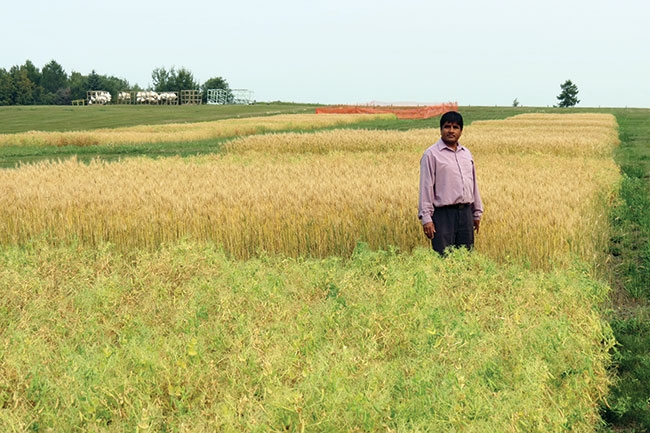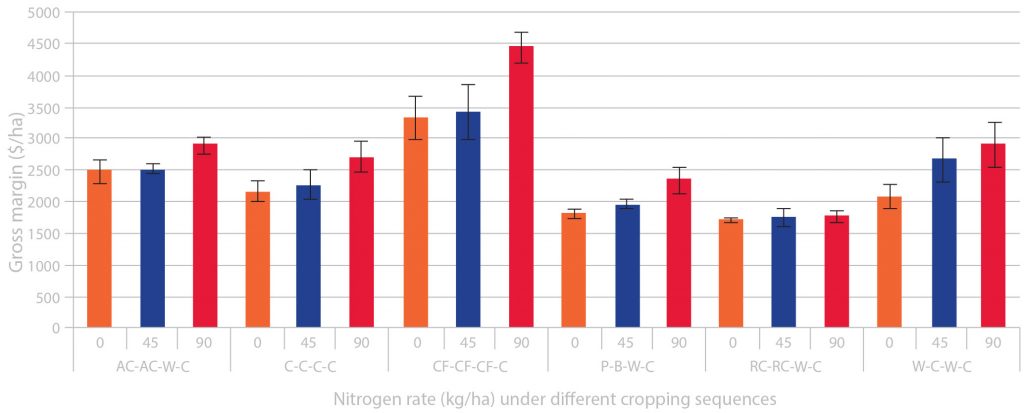
Features
Agronomy
Other Crops
Crop rotation study: Evaluating the impact of forage crops on profitability
In the Peace River region where production of creeping red fescue, alsike clover and red clover has been a mainstay for many farmers, tighter canola rotations have gradually displaced forage seed production. While this threatens the sustainability of the seed industry, more intense canola rotations may be costing farmers profit as well. That is the finding of a crop rotation study conducted by Agriculture and Agri-Food Canada (AAFC) at Beaverlodge, Alta.
November 24, 2017 By Bruce Barker
 Research by Nityananda Khanal and colleagues found that biennial and perennial forage-based rotations can be more profitable than short term canola rotations. In the Peace River region where production of creeping red fescue
Research by Nityananda Khanal and colleagues found that biennial and perennial forage-based rotations can be more profitable than short term canola rotations. In the Peace River region where production of creeping red fescueThere are a lack of studies that evaluated comparative economic and ecological advantage of annual and perennial crops in crop rotations,” says AAFC research scientist Nityananda Khanal. “In order to bridge this gap with a special reference to Peace Region of Western Canada, a crop rotation study involving various forages and annual crops was initiated in 2013. My colleagues and collaborators started this study before I joined the Forage Research Program at Beaverlodge in 2016.”
In 2013, a four year crop rotation study was set up to assess biennial and perennial forage crops grown for seed, and their impact on profitability. Six different crop rotations were established in 2013:
- Canola (C) -Canola-Canola-Canola
- Creeping red fescue (CF)-CF-CF-C
- Red clover (RC)-RC-Wheat-Canola
- Alsike clover (AC)-AC-Wheat-Canola
- Pea (P)-Barley-Wheat-Canola
- Wheat (W)-Canola-Wheat-Canola
For the non-legume crops of creeping red fescue, wheat, canola and barley, additional nitrogen treatments of 0, 45 and 90 kg of nitrogen (N) per ha (0, 40 and 80 lbs./ac.) were applied in the seed row for annual crops and as a fall broadcast treatment for creeping red fescue. A CrossSlot drill that separates seed and fertilizer was used to seed the plots and minimize the risk of germination damage with higher rates of N. Gross margins (commodity sale values minus variable costs) were calculated for each year, and cumulatively over the four years of the study.
Creeping red fescue provided highest four-year return
Combining the gross margin over the four years of the study (2013 to 2016), the rotation of three years of creeping red fescue followed by canola provided the highest returns. The creeping red fescue was harvested for seed, but the straw residue was not considered in the gross margin calculations. Gross margin for the creeping red fescue rotation was $1,799 per acre with 80 lb N (90 kg N per hectare) applied annually. Compared to a wheat-canola or canola-canola rotation, the creeping red fescue rotation far exceeded returns from those annual crops over the four cumulative years. Comparatively, the continuous canola rotation at the 90 kg N rate provided a cumulative gross return of approximately $1,092 per acre and a wheat-canola rotation provided about $1,171 per acre.
Certainly the price of commodities had a large influence on gross returns. Two years of red clover followed by wheat and canola had the lowest gross returns over the four years, reflective of the low commodity price for red clover seed. Alternatively, the other forage legume in rotation, alsike clover for two years followed by wheat and canola, had a cumulative gross margin statistically similar to continuous canola and wheat-canola rotations.
The pea-barley-wheat-canola rotation had the second lowest gross returns.
Nitrogen benefits of legumes
Khanal says the agronomic benefits of rotations integrating biennial forage legumes for seed production were evident in the succeeding plots of wheat and canola. Wheat and canola gross margins tended to be higher in alsike and red clover rotations than in annual rotations, specifically where zero or 45 kg of nitrogen (N) per hectare (N/ha) was applied.
“Wheat and canola receiving no fertilizer following a biennial stand of either red or alsike clover grown for seed produced significantly higher grain yields compared to rotations where those crops were preceded by annual crops such as peas, wheat, barley or canola,” Khanal says.
Similarly, without nitrogen fertilizer application, canola yield from forage legumes-based rotations were 40 to 70 per cent higher than those from annual crop sequences.
Looking at legume contribution to N requirements for the following canola or wheat crop, two years of alsike clover or red clover yielded the equivalent of applying 45 kg N to canola or 90 kg N to wheat.
Khanal plans on analyzing the results in further detail to include soil quality indicators. The study is also continuing from 2017 through 2021, and will look at profitability and whether the agro-ecological benefits of biennial and perennial forage crops to soil physical and chemical properties are better seen over a longer time period of time, particularly when compared to annual cropping system.
Print this page
